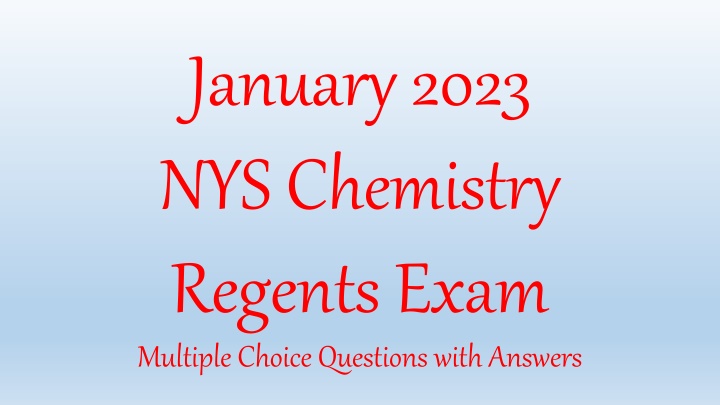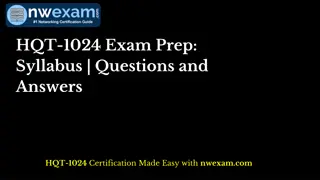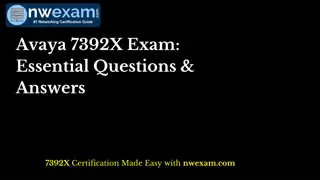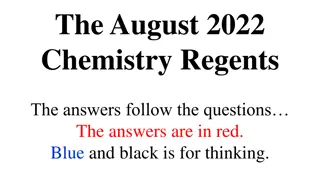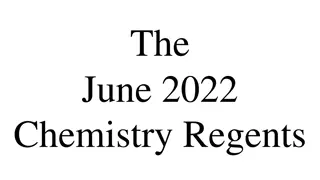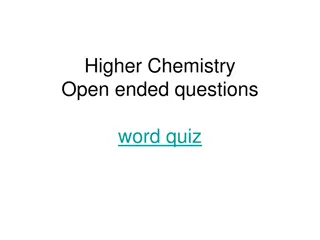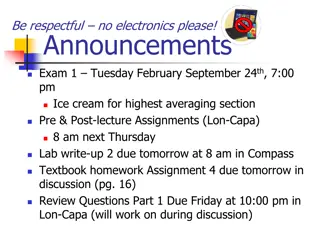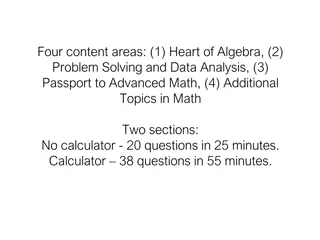January 2023 NYS Chemistry Regents Exam Multiple Choice Questions with Answers
Explore multiple choice questions from the January 2023 NYS Chemistry Regents exam, covering topics such as atomic structure, particle mass, and energy emission in excited atoms. Understand key concepts like conclusions from the gold foil experiment, particles with one atomic mass unit, and electron transitions in potassium atoms.
Download Presentation

Please find below an Image/Link to download the presentation.
The content on the website is provided AS IS for your information and personal use only. It may not be sold, licensed, or shared on other websites without obtaining consent from the author.If you encounter any issues during the download, it is possible that the publisher has removed the file from their server.
You are allowed to download the files provided on this website for personal or commercial use, subject to the condition that they are used lawfully. All files are the property of their respective owners.
The content on the website is provided AS IS for your information and personal use only. It may not be sold, licensed, or shared on other websites without obtaining consent from the author.
E N D
Presentation Transcript
January 2023 NYS Chemistry Regents Exam Multiple Choice Questions with Answers
1 Which conclusion was developed as a result of the gold foil experiment? (1) Atoms are mostly empty space. (2) All atoms are hard, indivisible spheres. (3) Atoms have different volumes. (4) All atoms have the same volume.
1 Which conclusion was developed as a result of the gold foil experiment? (1) Atoms are mostly empty space. (2) All atoms are hard, indivisible spheres. (3) Atoms have different volumes. (4) All atoms have the same volume. Atoms are mostly empty space, that why almost all of the alpha particles went right through the gold atoms in the foil. They do act like hard spheres, but they are not. Volume is kind of radius (or diameter) and all atoms have their own radii table S.
2 Which two particles each have a mass approximately equal to one atomic mass unit? (1) positron and proton (2) positron and electron (3) neutron and electron (4) neutron and proton
2 Which two particles each have a mass approximately equal to one atomic mass unit? (1) positron and proton (2) positron and electron (3) neutron and electron (4) neutron and proton Neutrons have mass (in high school) of 1 AMU. Protons also have the mass of 1 AMU. Electrons have NO MASS in high school. Positrons are in nuclear chem, they are odd radioactive particles that are like positive electrons also with no mass.
3 An excited potassium atom emits a specific amount of energy when one of its electrons moves from (1) the first shell to the fourth shell (2) the second shell to the fourth shell (3) the fourth shell to the fifth shell (4) the fourth shell to the second shell
3 An excited potassium atom emits a specific amount of energy when one of its electrons moves from (1) the first shell to the fourth shell (2) the second shell to the fourth shell (3) the fourth shell to the fifth shell (4) the fourth shell to the second shell Spectra is released when an excited electron in a higher orbital releases energy in order to return to the normal lower energy state (called the ground state). Choices 1, 2, and 3 are all getting excited, not emitting spectra. (one of these is not like the others)
4 Which list of elements includes a metal, a metalloid, and a noble gas? (1) Rb, Cl, Ne (2) Sr, Si, Rn (3) Rn, Cl, Ne (4) Si, Rb, Sr
4 Which list of elements includes a metal, a metalloid, and a noble gas? (1) Rb, Cl, Ne (2) Sr, Si, Rn = metal, metalloid, noble gas (3) Rn, Cl, Ne (4) Si, Rb, Sr Choice 1 has metal, nonmetal, noble gas Choice 3 has noble gas, nonmetal, noble gas Choice 4 has metalloid, metal, metal
5 Which element has the lowest density at 298 K and 101.3 kPa? (1) argon (2) fluorine (3) nitrogen (4) oxygen
5 Which element has the lowest density at 298 K and 101.3 kPa? (1) argon density = 0.001633 g/cm3 (2) fluorine density = 0.001553 g/cm3 (3) nitrogen density = 0.001145 g/cm3 (4) oxygen density = 0.001308 g/cm3 You can t know this answer, you must look up the density values on table S. The smallest value is for nitrogen.
6 Which phrase describes the crystal structure and properties of two different forms of solid carbon called diamond and graphite? (1) same crystal structure and same properties (2) same crystal structure and different properties (3) different crystal structures and different properties (4) different crystal structures and same properties
6 Which phrase describes the crystal structure and properties of two different forms of solid carbon called diamond and graphite? (1) same crystal structure and same properties (2) same crystal structure and different properties (3) different crystal structures and different properties (4) different crystal structures and same properties The vocabulary word here is allotrope, which are pure forms of an element with different physical structure (they bond together differently) giving different properties).
7 Which element has chemical properties most similar to sodium? (1) magnesium (2) oxygen (3) phosphorus (4) rubidium
7 Which element has chemical properties most similar to sodium? (1) magnesium (2) oxygen (3) phosphorus (4) rubidium Sodium Na, is in group 1, so we are looking for another group 1 metal (that also makes +1 cations, has 1 valence electron, is low density, soft, and reactive).
8 Which substance contains elements chemically combined in a fixed proportion? (1) manganese (2) methane (3) silicon (4) strontium
8 Which substance contains elements chemically combined in a fixed proportion? (1) manganese Mn (2) methane CH4 (3) silicon Si (4) strontium Sr Fixed proportion means it has a formula, made up of at least 2 different elements. Write out their formulas, the answer will bite you on the leg like a small dog.
9 Which property can be used to differentiate between a 50.-gram sample of solid potassium nitrate at STP and a 50.-gram sample of solid silver chloride at STP? (1) mass (2) temperature (3) phase (4) solubility
9 Which property can be used to differentiate between a 50.-gram sample of solid potassium nitrate at STP and a 50.-gram sample of solid silver chloride at STP? (1) mass (2) temperature (3) phase (4) solubility They both have the SAME MASS. They both have the SAME TEMPERATURE. Both of these are solids or the SAME PHASE. On table F, potassium nitrate is soluble in water, while silver chloride forms precipitates (it is insoluble) in water.
10 Which type of bond forms when electrons are equally shared between two atoms? (1) a polar covalent bond (2) a nonpolar covalent bond (3) a hydrogen bond (4) an ionic bond
10 Which type of bond forms when electrons are equally shared between two atoms? (1) a polar covalent bond (2) a nonpolar covalent bond (3) a hydrogen bond (4) an ionic bond Sharing electrons is covalent bonding. Ionic bonding is the transfer of electrons. Hydrogen bonds are intermolecular attractions. Sharing equally is NONPOLAR. Sharing unequally is polar.
11 Which statement describes the changes in bonding and energy that occur when a molecule of iodine, I2, forms two separate atoms of iodine? (1) A bond is formed as energy is absorbed. (2) A bond is formed as energy is released. (3) A bond is broken as energy is absorbed. (4) A bond is broken as energy is released.
11 Which statement describes the changes in bonding and energy that occur when a molecule of iodine, I2, forms two separate atoms of iodine? (1) A bond is formed as energy is absorbed. (2) A bond is formed as energy is released. (3) A bond is broken as energy is absorbed. (4) A bond is broken as energy is released. This is ALWAYS on the exam, when a bond forms, energy is released. This is the OPPOSITE, I2 I + I To break this bond, energy must be absorbed.
12 The degree of polarity in the bond between a hydrogen atom and an oxygen atom in a molecule of water can be assessed using the difference in (1) densities (2) electronegativities (3) melting points (4) intermolecular forces
12 The degree of polarity in the bond between a hydrogen atom and an oxygen atom in a molecule of water can be assessed using the difference in (1) densities (2) electronegativities (3) melting points (4) intermolecular forces A difference in electronegativity values means a polar bond has formed. The greater the difference, the more polar the bonds are.
13 Which substance can not be broken down by a chemical change? (1) ammonia (2) ethanol (3) krypton (4) water
13 Which substance can not be broken down by a chemical change? (1) ammonia NH3 on Table L (2) ethanol C2H5OH on Table R (3) krypton Kr on Periodic Table (4) water H2O you knew this before you met me! Opposite of an earlier question, write out the formulas, watch out for small dogs! The simplest substance is an element, which cannot be broken down into simpler substances. The other three can.
14 Which sample of matter is a mixture? (1) CO2(G) (2) CCl4(L) (3) MgCl2(AQ) (4) Sn(s)
14 Which sample of matter is a mixture? (1) CO2(G) (2) CCl4(L) (3) MgCl2(AQ) (4) Sn(s) 1 is a compound in the gas phase 2 is a compound in the melted liquid phase 3 is a compound is AQUEOUS which means dissolved into water (mixture) 4 is an element in the solid phase The answer was in the PHASE SYMBOL here. Every little thing matters, details!
15 Which term is used to express the concentration of an aqueous solution? (1) parts per million (2) heat of fusion (3) pressure at 0 C (4) volume at 0 C
15 Which term is used to express the concentration of an aqueous solution? (1) parts per million (2) heat of fusion (3) pressure at 0 C (4) volume at 0 C Back page of reference tables in the middle is CONCENTRATION. Usually, it is molarity but right in the box is also parts per million. Put your finger in the box.
16 The particles in which sample have the lowest average kinetic energy? (1) 50. g of sulfur at 273 K (2) 40. g of aluminum at 298 K (3) 30. g of sulfur at 303 K (4) 20. g of aluminum at 323 K
16 The particles in which sample have the lowest average kinetic energy? (1) 50. g of sulfur at 273 K (2) 40. g of aluminum at 298 K (3) 30. g of sulfur at 303 K (4) 20. g of aluminum at 323 K Lowest average means the AMOUNT does not matter. Average PER GRAM. Lowest average means lowest temperature.
17 Which process represents a chemical change? (1) Iodine sublimes. (2) Water evaporates. (3) An ice cube melts. (4) A candle burns in air
17 Which process represents a chemical change? (1) Iodine sublimes. I2(S) I2(G) (2) Water evaporates. H2O(L) H2O(G) (3) An ice cube melts. H2O(S) H2O(L) (4) A candle burns in air C20H40(S) + O2(G) CO2(G) + H2O(G) Write out the symbols, new stuff must form, with new properties for a chemical change (reaction) to take place.
18 Which equation represents a physical equilibrium? (1) NaCl(s) Na+1(AQ)+ Cl-1(AQ) (2) 2SO2(G) O2(G)+ 2SO3(G) (3) 3O2(G) 2O3(G) (4) N2(L) N2(G)
18 Which equation represents a physical equilibrium? (1) NaCl(s) Na+1(AQ)+ Cl-1(AQ) (2) 2SO2(G) O2(G)+ 2SO3(G) (3) 3O2(G) 2O3(G) (4) N2(L) N2(G) 1 is solvation, not dynamic equilibrium. 2 is an equilibrium, but it s a chemical change in both directions. 3 is not physically the same, this is oxygen and ozone in an equilibrium 4 is just a physical or PHASE change
19 Systems in nature tend to undergo changes toward (1) higher energy and higher entropy (2) higher energy and lower entropy (3) lower energy and higher entropy (4) lower energy and lower entropy
19 Systems in nature tend to undergo changes toward (1) higher energy and higher entropy (2) higher energy and lower entropy (3) lower energy and higher entropy (4) lower energy and lower entropy This is always on the regents exam, like a Led Zepplin song (Thank You).
20 Which formula represents a hydrocarbon? (1) C2H6 (2) C2H5OH (3) C2H5Cl (4) C2H6O
20 Which formula represents a hydrocarbon? (1) C2H6 this is ONLY hydrogen and carbon (good) (2) C2H5OH this has oxgyen (bad) (3) C2H5Cl this has chlorine (also bad) (4) C2H6O this has oxygen (bad) Table Q shows the three kinds of hydrocarbons (alkanes, alkenes, and alkynes). All are made up of ONLY hydrogen and carbon atoms, hence the name and hence my use of the word hence !
21 Which statement describes the bonding in an alkyne molecule? (1) There is at least one carbon-to-carbon double bond. (2) There is at least one carbon-to-carbon triple bond. (3) There is at least one carbon-to-oxygen single bond. (4) There is at least one carbon-to-oxygen double bond.
21 Which statement describes the bonding in an alkyne molecule? (1) There is at least one carbon-to-carbon double bond. (2) There is at least one carbon-to-carbon triple bond. (3) There is at least one carbon-to-oxygen single bond. (4) There is at least one carbon-to-oxygen double bond. Table Q tells you that alkynes have only one triple bond in high school chem, but may have more than one in college and IRL.
22 Which compound has a functional group that contains two oxygen atoms? (1) 1-propanamine (2) 2-chloropropane (3) methyl propanoate (4) methyl ethyl ether
22 Which compound has a functional group that contains two oxygen atoms? (1) 1-propanamine (2) 2-chloropropane (3) methyl propanoate (4) methyl ethyl ether Table R has a column called FUNCTIONAL GROUPS. 1 has NO oxygen atoms 2 has NO oxygen atoms 3 is the answer with a COO functional group 4 has ONE oxygen atom
23 Which term identifies a type of organic reaction? (1) deposition (2) distillation (3) polymerization (4) vaporization
23 Which term identifies a type of organic reaction? (1) deposition (2) distillation (3) polymerization (4) vaporization Deposition is the phase change from gas to solid Distillation is boiling apart 2 or more substances by different BP s. Polymerization is the organic reaction to make plastics. Vaporization is the phase change liquid to gas.
24 In an electrochemical cell, oxidation occurs at the (1) anode (2) cathode (3) salt bridge (4) switch
24 In an electrochemical cell, oxidation occurs at the (1) anode (2) cathode (3) salt bridge (4) switch LEO the Lion goes GER Loss of electrons is oxidation. Gain of electrons is reduction. Leo is a RED CAT, which reminds you that reduction happens at the cathode. The opposite of reduction is oxidation; which has to happen at the other electrode, called the ANODE.
25 Which energy conversion occurs in an operating electrolytic cell? (1) chemical energy to electrical energy (2) electrical energy to chemical energy (3) nuclear energy to electrical energy (4) electrical energy to nuclear energy
